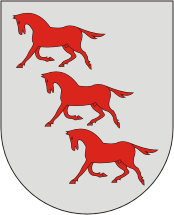 Alternate names: Dusetos [Lith], Dusiat [Yid], Dusiaty [Rus, Pol], Duseati, Dusetoi, Dusjaty, Dusyat, Dusetai, Dosetas, Russian: Дусяты. דוסיאַט-Yiddish. 55°45' N, 25°51' E,16 miles W of Zarasai (Novo-Aleksandrovsk), 18 miles SE of Rokiškis (Rakishok), 20 miles NNE of Utena (Utiyan) in Ezhreni (Zarasai) district. 1900 Jewish population: 1,158.
Alternate names: Dusetos [Lith], Dusiat [Yid], Dusiaty [Rus, Pol], Duseati, Dusetoi, Dusjaty, Dusyat, Dusetai, Dosetas, Russian: Дусяты. דוסיאַט-Yiddish. 55°45' N, 25°51' E,16 miles W of Zarasai (Novo-Aleksandrovsk), 18 miles SE of Rokiškis (Rakishok), 20 miles NNE of Utena (Utiyan) in Ezhreni (Zarasai) district. 1900 Jewish population: 1,158.
Ayarah hayetah be-Lita; Dusiat bi-re'i ha-zikhronot (Tel Aviv, 1989).
- Pinkas ha-kehilot; entsiklopediya shel ha-yishuvim le-min hivasdam ve-ad le-aher shoat milhemet ha-olam ha-sheniya: Lithuania
(Jerusalem, 1996), p. 204: "Dusetos" Encyclopedia of Jewish Life (2001), p. 348: "Dusetos". ShtetLink. [March 2011]
Located on the banks of the River Sventoji near lakes Sartai, Sventoji, and Dusetas, forests surround the shtetl. The neighboring towns include Antaliept (10 km), Salok (26 km), Ezerenai (36 km), Utian (36 km) and Rakishok (38 km). Dusetos, dating from 1530, borders Seventoji River and the Sarta, Swantusia, and Dusetos lakes amid scenic forests. Settled by free tradesmen and merchants as well as Jews, the lands was owned by the Church. 1847 Jewish popuation: 486. 1897 Jewish population: 1,158 (89%). Dusetos was a considerable distance from the railway line. Neighboring towns were reached by gravel road. Three streets of wooden homes. On April 23, 1905 violent anti-Soviet riots mirrored those in Czarist Russia. Jewish shops, property, and torahs were destroyed. In 1905 and again in 1910, large fires broke out, the 1910 fire destroying half of the Jewish homes and stores along with the old synagogue. The 1910 fire diminished the Jewish community so that by 1912, only 704 Jews of about 250 families (70%) remained.By 1912, only 704 Jews (70% of the population) remained (about 250 families). Wednesday was market day; two fairs were held annually. Thirty stores in the shtetl all belonged to Jews. Some farmed leased land; others were either tradesmen or merchants conducting business mainly with Daugavpils (Latvia) on the road to Zarasai. During WWI, Jews did not leave Dusiat, but later on many did move to larger towns. After World War I, by 1921, only 100 families remained. On the eve of the Holocaust, only eighty families lived there. The new borders cut Dusetos off from Dvinsk. Anti-Semitism was incited by the local Verslininkai [ultranationalists], who opposed the "foreign" merchants and artisans. The Jews who remained did peddling, trading, and manual labor and worked in workshops: 32 tradesmen (eight tailors), five butchers, five shoemakers, four metalworkers, two coppersmiths, and and also a few farmers. Two flour mills, a candy factory, and an electric power station were all owned by Jews. A branch of the Jewish Bank was opened in November 1924. A bad economy encouraged many Jews to emigrate to South Africa and the USA and a few to Palestine. Before World War I, five or six Hebrew Schools and one shul had been restored. In independent Lithuania one elementary school had 65 pupils. The school conducted evening Hebrew classes and had a drama club and library. Before World War II began, 80 Jewish families lived in the town. [March 2009]
CEMETERY: Cemetery is generally neglected, though grass is sometimes cut. A wall with a Hebrew sign surrounds. Stones are sunken, leaning, torn out, and missing. Used until the Holocaust, the site is probably 150-200 years old. About 300 stones are now visible. No caretaker and no Jews are in the town. Lithuanian mayor could be used as contact person: Dienemis Algis, Vytauto Gatve 29, dusetos. Tel.: 56631. Another contact could be Pioder (Fievel) Treger, Taryby aikste 20/2 #13, Zarasai. Tel: 52962. He is one of a few Jews still living in Zarasai, near Dusetos. [source: ? date? before 1997]
MASS GRAVES: Forest of Krakyne, Deguciai county; 190-191; pic. # 348-350 US Commission for the Preservation of America's Heritage Abroad.
When the German army approached, a number of families fled to Russia. The large majority who tried to flee on foot returned as the Germans had closed. Before the Germans even entered the town, Lithuanian thugs had gone wild, harrassing the Jewish population. Jews were ejected from their homes and forced into a Ghetto that consisted of a few small homes belonging to some Jewish families as well as the dairy sheds and adjoining storerooms behind the bridge. Each white-band guarding the Ghetto tried to be more cruel than his comrade. The homes of the Jews and all their belongings were appropriated by the Lithuanians of Dusetos and surrounding villages. Until August 26, 1941, Jewish men were forced to do the hard manual labor in the town and the surrounding fields belonging to local farmers. On the massacre day, the men with the old and feeble with smaller children in wagons were taken on a forced march to Daugutzai Forest adjoining the village of Sauvitzianai. They were murdered with the Jews of Zarasai (Eseranai) and surrounding villages and towns. One woman and two of her children miraculously escaped. She had overheard the Lithuanian guards saying that the next day, they would slaughter all the Jews. She grabbed her two children and escaped, travelling through forests and fields until they slipped into the Kovno Ghetto; she and her children perished in the "Great Aktion" in the Kovno Ghetto.[March 2009]
- Shtetl Finder (1989), p. 22: "Dusiat".
- LitvakSIG
